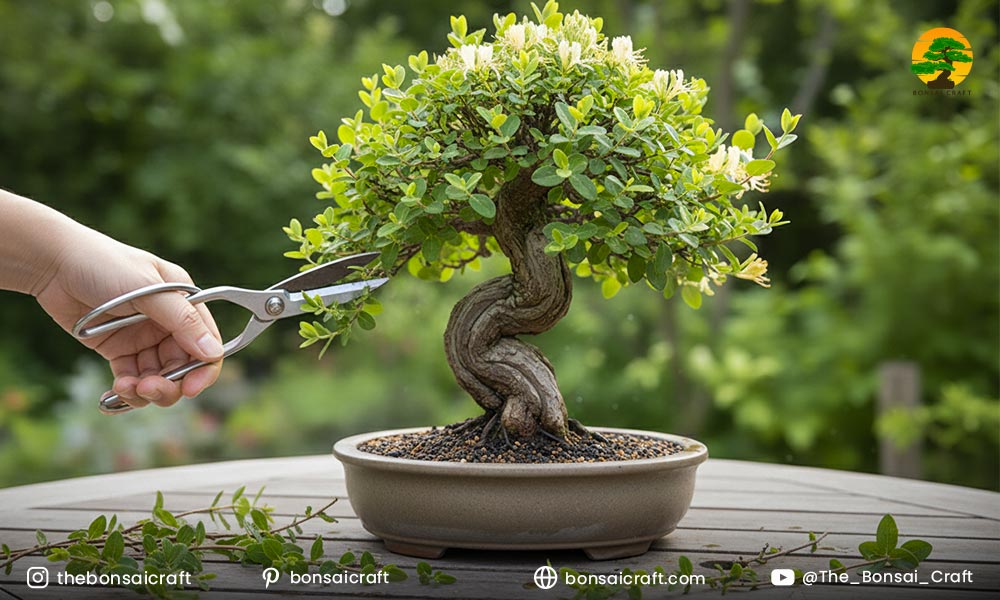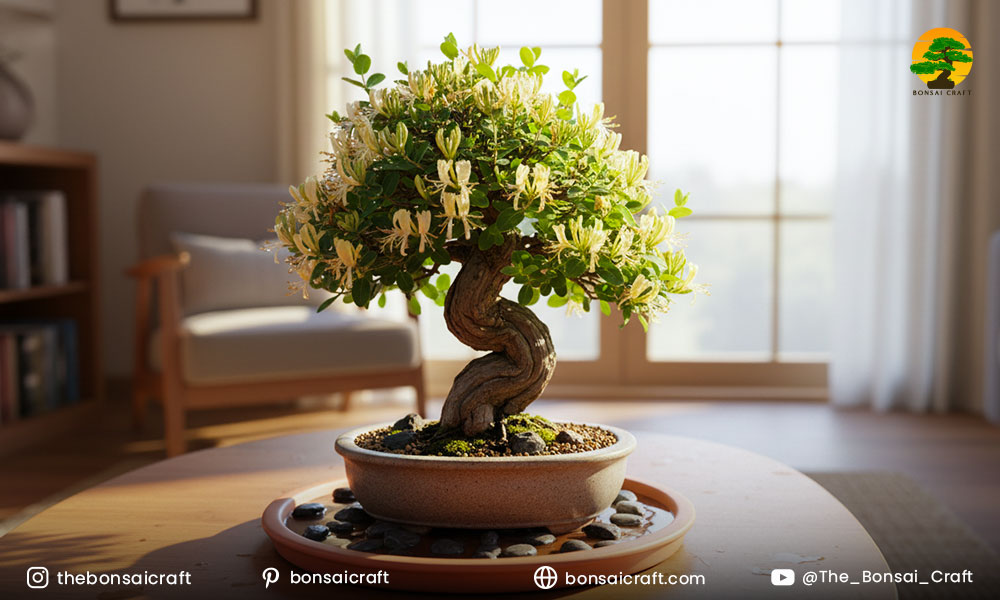
Bonsai is more than just a horticultural practice—it’s a discipline that blends patience, artistry, and dedication. For those new to bonsai care, choosing the right species is crucial for success. One beautiful yet often overlooked option is the honeysuckle bonsai. With its aromatic blossoms, vibrant foliage, and adaptable growth habits, the honeysuckle bonsai is a perfect choice for beginners looking to start their bonsai journey.
As someone who has worked with a variety of bonsai species over the years, I can attest to the satisfaction of nurturing a honeysuckle bonsai from a tiny sapling to a flourishing tree. This article will guide you through all aspects of honeysuckle bonsai care, including tips on watering, pruning, propagation, and more. Whether you’re interested in growing honeysuckle indoors or outdoors, you’ll find actionable advice backed by experience to help your plant thrive.
What is Honeysuckle Bonsai?
The honeysuckle bonsai is a miniature version of the Lonicera honeysuckle plant. It’s renowned for its fragrant flowers, fast growth, and versatility in bonsai cultivation.
The honeysuckle bonsai is derived from various species of the Lonicera honeysuckle family, including the Japanese honeysuckle bonsai, cape honeysuckle bonsai, and other varieties. These plants are characterized by their fast-growing nature and sweet-smelling flowers, which make them a favorite among bonsai enthusiasts. Bonsai honeysuckles are typically grown for their ability to produce clusters of small, fragrant flowers, which can add both color and fragrance to any indoor or outdoor space.
Honeysuckle bonsai trees can be shaped and pruned into traditional bonsai forms like formal upright or informal upright styles. Their ability to be trained into different shapes and sizes makes them ideal for beginners and experienced bonsai growers alike. The growth pattern of honeysuckle allows for a wide variety of styling options, meaning you can create a bonsai that suits your aesthetic preferences while still enjoying a relatively easy care regimen.
Honeysuckle Bonsai Care Essentials

Watering Your Honeysuckle Bonsai
Water your honeysuckle bonsai thoroughly, but ensure the soil has proper drainage. Water only when the top layer of soil feels dry to the touch.
Proper watering is one of the most important aspects of honeysuckle bonsai care. Bonsai plants, including honeysuckle bonsai, require consistent moisture, but overwatering can lead to root rot. To avoid this, always check the top layer of the soil—if it feels dry, it’s time to water. However, make sure the soil is well-draining to prevent water from accumulating around the roots.
Watering should be done thoroughly so that the roots receive sufficient moisture. This encourages deeper root growth and ensures your honeysuckle bonsai remains healthy. Use a watering can with a fine nozzle to ensure an even distribution of water. Avoid letting water sit in the saucer beneath the pot, as stagnant water can cause the roots to rot.

Pruning Your Honeysuckle Bonsai
Prune your honeysuckle bonsai regularly to maintain its shape and encourage healthy growth. Trim back any unwanted or overly long branches.
Pruning is essential for maintaining the aesthetic of your honeysuckle bonsai. Since honeysuckles are naturally fast-growing, regular pruning is necessary to keep the tree compact and prevent it from becoming too leggy. Use sharp, clean pruning shears to trim away dead or damaged branches and cut back new growth to maintain the desired shape.
The best time to prune is during the growing season, typically in late spring or early summer. However, you can also prune lightly throughout the year to control the shape. If you’re training your honeysuckle bonsai into a specific shape, such as the formal upright or cascade, regular pruning will help guide the growth in the desired direction.
Be cautious not to over-prune, as this can stress the plant. Always leave enough foliage to ensure the plant can continue photosynthesizing and growing effectively.
Fertilizing Honeysuckle Bonsai
Fertilize your honeysuckle bonsai every 4-6 weeks during the growing season with a balanced fertilizer to support healthy growth and flowering.
To promote healthy growth, it’s essential to fertilize your honeysuckle bonsai regularly during its active growing season (spring to early autumn). A balanced, water-soluble fertilizer with an equal ratio of nitrogen (N), phosphorus (P), and potassium (K) is ideal. Applying fertilizer every 4-6 weeks will provide the necessary nutrients for healthy foliage and vibrant flowers.
In the winter, when the honeysuckle is dormant, you can reduce or stop fertilization entirely. Too much fertilizer during the dormant period can lead to poor plant health and imbalanced growth once the plant resumes its active cycle.
Potting and Repotting Honeysuckle Bonsai
Repot your honeysuckle bonsai every 2-3 years to refresh the soil and ensure proper root development. Choose a pot that allows for adequate drainage.
Repotting is an important part of honeysuckle bonsai care. As your plant grows, it will outgrow its pot, and the soil will lose its nutrients. Repotting helps refresh the soil, provides more space for root growth, and ensures that your honeysuckle bonsai remains healthy and well-nourished. The best time to repot is during early spring, just before the plant begins to actively grow.
When choosing a pot, make sure it has proper drainage holes to prevent water from accumulating at the bottom. If you’re planning to train your honeysuckle bonsai into a specific shape, you may want to select a pot that complements the tree’s style. For example, a shallow, wide pot works well for bonsai trees that spread outward, while a deeper pot is better suited for upright styles.

Can Honeysuckle Bonsai Grow Indoors?
Yes, honeysuckle bonsai can be grown indoors, but they need plenty of sunlight, humidity, and proper care to thrive.
Many beginners wonder, “Can honeysuckle grow indoors?” The answer is yes, but honeysuckle bonsai plants require specific conditions to thrive indoors. Since they are accustomed to full sun, make sure to place your honeysuckle indoors in a location that gets at least 4-6 hours of direct sunlight daily. A south-facing window is often the best choice.
In addition to sunlight, honeysuckle bonsai trees need high humidity to thrive. If the air in your home is dry, especially in winter, consider placing the plant on a humidity tray filled with water and pebbles. Alternatively, you can mist the leaves regularly to maintain moisture levels.
Finally, honeysuckles prefer temperatures between 60°F and 75°F (15-24°C). Ensure the room is not too hot or too cold, and avoid placing your honeysuckle indoors near air vents or drafty windows.
How to Propagate Honeysuckle Bonsai
You can propagate honeysuckle bonsai by taking semi-hardwood cuttings, applying rooting hormone, and placing them in a humid environment until roots develop.
Propagating a honeysuckle bonsai is a rewarding process, and it’s often done by taking cuttings. Here’s how to propagate honeysuckle bonsai successfully:
- Choose Healthy Stems: Select healthy, semi-hardwood stems from the current year’s growth. Cut a 4-6 inch section from the stem just below a node (where the leaf joins the stem).
- Prepare the Cutting: Remove any leaves from the bottom half of the cutting to expose the stem.
- Apply Rooting Hormone: Dip the cut end of the stem into rooting hormone, which encourages root growth.
- Plant the Cutting: Place the cutting in a pot filled with a well-draining soil mix. A mix of peat moss and perlite works well.
- Create Humidity: To encourage root development, place the pot in a warm, humid environment. You can use a mini greenhouse or cover the pot with a plastic bag to maintain humidity.
- Wait for Roots: Keep the cutting in indirect light and mist it regularly. After 4-6 weeks, roots should begin to form, and you can transplant the cutting into a larger pot.
Conclusion
Caring for a honeysuckle bonsai is an enjoyable and rewarding experience that allows you to grow a stunning, fragrant miniature tree. By following the proper honeysuckle bonsai care techniques—including regular watering, pruning, and fertilizing—you can ensure your tree thrives. Whether you grow it indoors or outdoors, honeysuckle bonsai offers beautiful flowers and lush foliage, making it an ideal choice for beginners.
As someone who has nurtured honeysuckle bonsai trees for years, I recommend taking the time to understand the plant’s needs and adjusting your care routine as it grows. With patience and dedication, your honeysuckle bonsai will flourish and become a true masterpiece.
FAQs on Honeysuckle Bonsai
How do I care for a honeysuckle bonsai?
The honeysuckle bonsai needs bright sunlight, well-draining soil, consistent watering, and regular pruning. Fertilize during the growing season and repot every 2–3 years.
Can honeysuckle grow indoors?
Yes, honeysuckle indoors can thrive with enough light and humidity. Place near a sunny window, mist regularly, and monitor for pests. Outdoor growing is still better.
How do you propagate honeysuckle bonsai?
To propagate honeysuckle, use semi-hardwood cuttings in summer or layering in spring. Rooting hormone and moist soil increase success rates.
When should I prune honeysuckle bonsai?
Prune in late winter for structure and throughout summer for maintenance. Remove spent flowers to encourage reblooming.
How often should I water honeysuckle bonsai?
Water whenever the topsoil feels slightly dry. Daily watering may be needed in summer, while less is required in cooler months.
